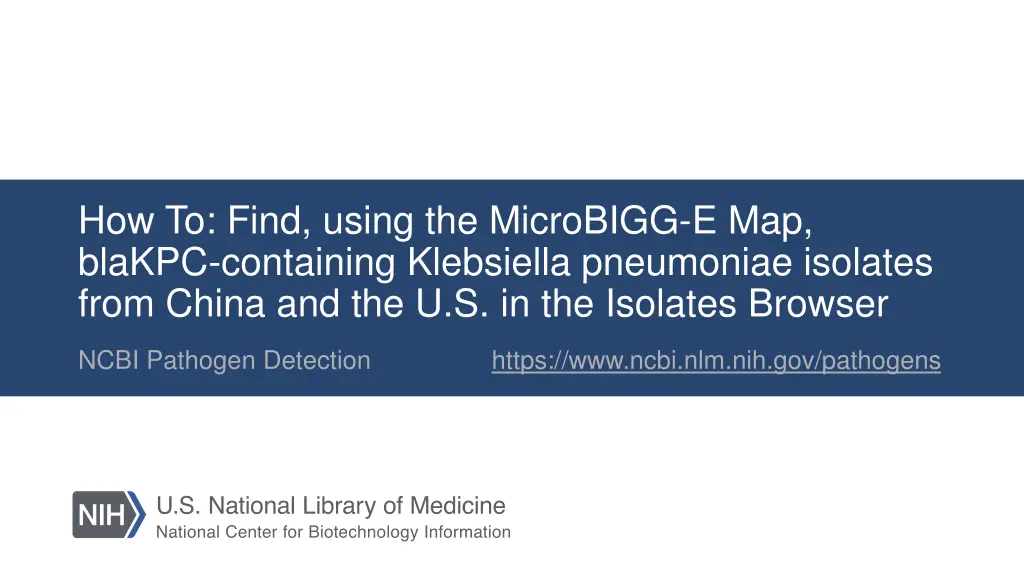
Find blaKPC-Containing Klebsiella pneumoniae Isolates Using MicroBIGG-E Map
Discover how to locate blaKPC-containing Klebsiella pneumoniae isolates from China and the U.S. using the MicroBIGG-E Map in the Isolates Browser on NCBI Pathogen Detection. Follow the step-by-step guide provided to narrow down the search by organism group, element symbol, and geographical location to analyze the distribution of KPC alleles between the two countries. Utilize the Isolates Browser to explore clusters of KPC-containing isolates further and gain valuable insights.
Uploaded on | 0 Views
Download Presentation

Please find below an Image/Link to download the presentation.
The content on the website is provided AS IS for your information and personal use only. It may not be sold, licensed, or shared on other websites without obtaining consent from the author. If you encounter any issues during the download, it is possible that the publisher has removed the file from their server.
You are allowed to download the files provided on this website for personal or commercial use, subject to the condition that they are used lawfully. All files are the property of their respective owners.
The content on the website is provided AS IS for your information and personal use only. It may not be sold, licensed, or shared on other websites without obtaining consent from the author.
E N D
Presentation Transcript
How To: Find, using the MicroBIGG-E Map, blaKPC-containing Klebsiella pneumoniae isolates from China and the U.S. in the Isolates Browser NCBI Pathogen Detection https://www.ncbi.nlm.nih.gov/pathogens
At a glance Use the MicroBIGG-E Map https://www.ncbi.nlm.nih.gov/pathogens/microbigge_map/ Select "Klebsiella pneumoniae" from the Organism Group dropdown menu Select "Element symbol" in Filters and search for "blaKPC" Use the MicroBIGG-E International Map Panel to restrict data to isolates from China and the U.S. Use the Cross-Browser option to display selected isolates in the Isolates Browser pd-help@ncbi.nlm.nih.gov
3 https://www.ncbi.nlm.nih.gov/pathogens/microbigge_map/ https://www.ncbi.nlm.nih.gov/pathogens/microbigge_map/ 2. Select Klebsiella pneumoniae as Organism group 4. Enter blaKPC in filter panel search bar 5. Select blaKPC in filter 3. Select Element symbol
4 https://www.ncbi.nlm.nih.gov/pathogens/microbigge_map/ https://www.ncbi.nlm.nih.gov/pathogens/microbigge_map/ 6. Select China by clicking its outline 7. Select the U.S. by clicking its outline
5 https://www.ncbi.nlm.nih.gov/pathogens/microbigge_map/ https://www.ncbi.nlm.nih.gov/pathogens/microbigge_map/ 8. Select China to show the distribution of KPC alleles in isolates from China 10. Select both China and the U.S. to show the distribution of KPC alleles in isolates from both countries combined Note the difference in KPC allele distributions between the two countries 9. Select the U.S. to show the distribution of KPC alleles in isolates from the U.S.
6 https://www.ncbi.nlm.nih.gov/pathogens/microbigge_map/ https://www.ncbi.nlm.nih.gov/pathogens/microbigge_map/ 11. Select the Show in Isolates button
7 https://www.ncbi.nlm.nih.gov/pathogens/microbigge_map/ https://www.ncbi.nlm.nih.gov/pathogens/microbigge_map/ 12. You can work with the data in the Isolates Browser, such as examining this large cluster composed of mostly KPC- containing isolates
More information For full help documentation of the MicroBIGG-E Map see: LINK For full help documentation of MicroBIGG-E see: https://www.ncbi.nlm.nih.gov/pathogens/pathogens_help/#microbigge Questions and further help: email pd-help@ncbi.nlm.nih.gov pd-help@ncbi.nlm.nih.gov
